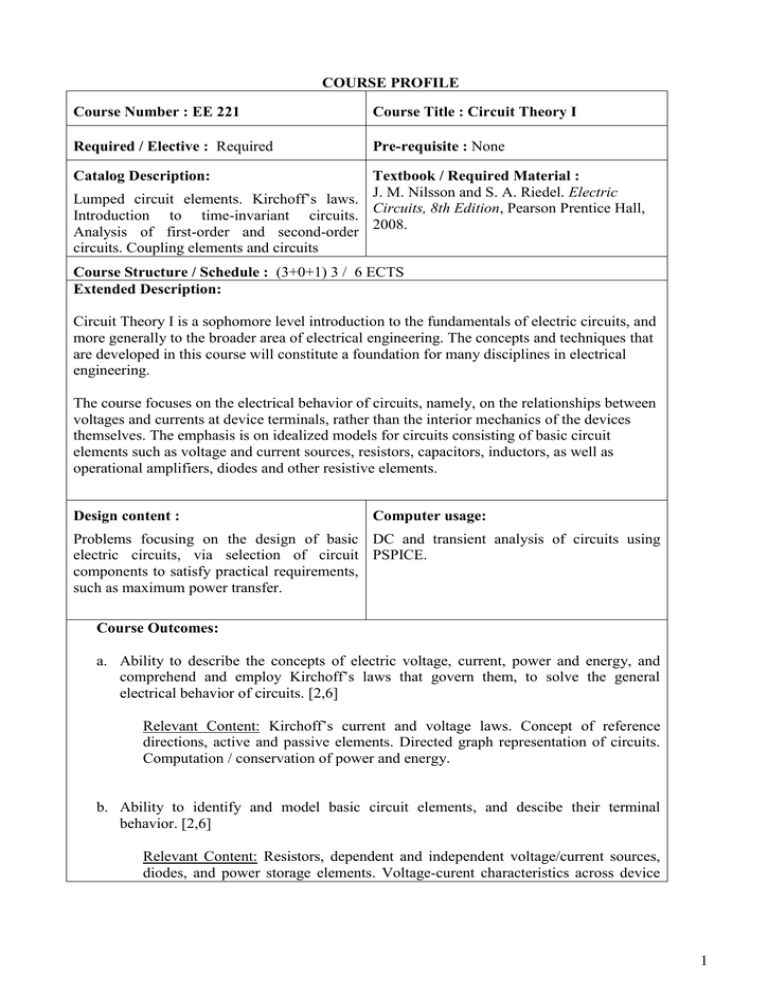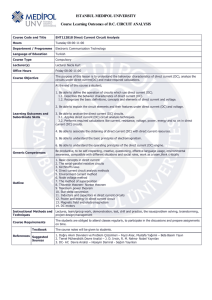
COURSE PROFILE
Course Number : EE 221
Course Title : Circuit Theory I
Required / Elective : Required
Pre-requisite : None
Catalog Description:
Textbook / Required Material :
Lumped circuit elements. Kirchoff’s laws. J. M. Nilsson and S. A. Riedel. Electric
Introduction to time-invariant circuits. Circuits, 8th Edition, Pearson Prentice Hall,
Analysis of first-order and second-order 2008.
circuits. Coupling elements and circuits
Course Structure / Schedule : (3+0+1) 3 / 6 ECTS
Extended Description:
Circuit Theory I is a sophomore level introduction to the fundamentals of electric circuits, and
more generally to the broader area of electrical engineering. The concepts and techniques that
are developed in this course will constitute a foundation for many disciplines in electrical
engineering.
The course focuses on the electrical behavior of circuits, namely, on the relationships between
voltages and currents at device terminals, rather than the interior mechanics of the devices
themselves. The emphasis is on idealized models for circuits consisting of basic circuit
elements such as voltage and current sources, resistors, capacitors, inductors, as well as
operational amplifiers, diodes and other resistive elements.
Design content :
Computer usage:
Problems focusing on the design of basic DC and transient analysis of circuits using
electric circuits, via selection of circuit PSPICE.
components to satisfy practical requirements,
such as maximum power transfer.
Course Outcomes:
a. Ability to describe the concepts of electric voltage, current, power and energy, and
comprehend and employ Kirchoff’s laws that govern them, to solve the general
electrical behavior of circuits. [2,6]
Relevant Content: Kirchoff’s current and voltage laws. Concept of reference
directions, active and passive elements. Directed graph representation of circuits.
Computation / conservation of power and energy.
b. Ability to identify and model basic circuit elements, and descibe their terminal
behavior. [2,6]
Relevant Content: Resistors, dependent and independent voltage/current sources,
diodes, and power storage elements. Voltage-curent characteristics across device
1
terminals.
c. Ability to derive, comprehend, and apply techniques of circuit analysis in resistive, opamp, RL, RC and RLC circuits, and to identify the best technique for the analysis of a
given circuit. [2,6,7]
Relevant Content: Interconnection of circuit elements. Analysis of simple resistive,
RL, RC, RLC and op-amp circuits. Use of circuit analysis techniques such as mesh
current, node voltage, source transformation, Thevenin and Norton equivalents, to
solve for the unknown voltage, current, power and energy characteristics.
d.
Ability to obtain equivalent representations, and simplified models of circuits. [2,6]
Relevant Content: Thevenin and Norton equivalents, source transformations, delta
to wye transformations, maximum power transfer.
e.
Ability to design and simulate circuits that meet certain requirements or perform
simple tasks, using basic tools of circuit analysis. [5,6,7,11]
Relevant Content: Analysis of resistive, op-amp, RL, RC, and RLC circuits.
Formulating necessary circuit equations and solving for the unknown component
values. Verifying techniques of circuit analysis, i.e. node-voltage and mesh-current
method, source transformation; computation of voltage, current, power and energy
characteristics for resistive elements, op-amps, power storage elements and DC
sources; natural and step responses of RL, RC and RLC circuits through the use of
SPICE simulations..
f. Ability to analyze circuits with DC sources, describe them using a system of equations,
and solve them using linear algebra and differential equations [2,6]
Relevant Content: Solution of linear equations with multiple unknowns; solution
of first order and second order differential equations; voltage-current
characteristics of ideal circuit elements; computation of power and energy.
The contribution of this course to the program outcomes can be rated as follows:
Outcomes 2,6 : SIGNIFICANT
Outcomes 7 : MODERATE
Outcomes 5, 11: SOME
Recommended reading:
L. O. Chua, C. A. Desoer, E. S. Kuh. Linear and Nonlinear Circuits. McGraw Hill, 1987.
Teaching Methods:
Pre-readings encouraged by reading quizzes, weekly homework encouraged by homework
quizzes, lecture and problem/discussion sessions.
Assessment Methods:
-
Exams (written) [Course outcomes a,b,c,d,e,f].
2
-
Pop-quizzes (reading and homework quizzes) [a,b,c,d,f].
-
Class surveys, exit surveys [c,e,f].
Student Workload:
Preparatory reading
42 hrs
Lectures,workshop, discussions
70 hrs
Homework and self study
45 hrs
Computer Assignments
15 hrs
Final Exam
TOTAL ………………………
Prepared by : Onur Kaya
3 hrs
175 hrs to match 25 x 7 ECTS
Revision Date : 03/02/2010
3




